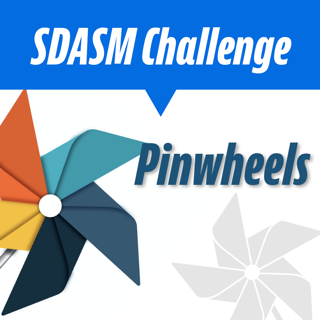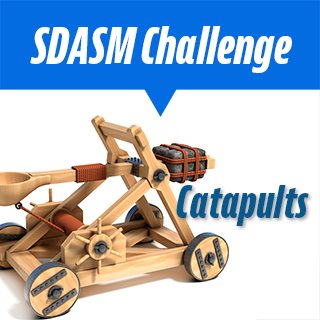The Museum will be closed January 12th - January 16th in preparation for our new Special Exhibition Ripley's Believe It or Not!. Museum reopens Saturday January 17th. New Exhibit opens January 31st!


Let’s explore the phases of the moon! For the next few weeks, peek outside at the same time each night and record your observations about the moon. What size is it? How bright is it? Is it in the same place each night? Make predictions about what you think will happen the next night. To learn more about the moon, including simulations of why the moon looks like it changes shape, visit moon.nasa.gov.

Ready for some excavation? Grab a chocolate chip cookie and see if you can engineer tools to remove the chocolate chips without damaging the surrounding cookie. Don’t have a cookie? Try removing the seeds from a piece of fruit, such as a strawberry, or sorting out different types of cereal from a mix. Which tool is most effective?

Time to celebrate spring! Pinwheels harness the movement of air to spin a wheel. You’ll need a square piece of paper and something to hold it together, such as a paperclip, bobby pin, or a piece of wire. Watch Mia disassemble her pinwheel and challenge yourself to reverse engineer your own. What happens if you make your pinwheel smaller or larger? How can you make your pinwheel spin faster?

Dream big with your dream home! Mia’s favorite materials are spaghetti and marshmallows, but everything from popsicle sticks, toothpicks, pencils work well and can be held together with clay, play dough, tape or string. Draw a blueprint for your house: is your dream house maybe in a tree or a cave or a castle? Use your blueprint to build your house, and work with your friends and family to make a neighborhood!

Today we are trying an experiment similar to some completed on the International Space Station! Find a bean inside your cupboard, a small houseplant in your window, or forage outside for local seeds. Next, cover your chosen subject with dirt and a little water inside of a plastic bag, or anything that can be sealed. Have an adult help you hang your experiment with tape or string to see if your plant can grow upside down! Make observations each day about what’s happening to the stem, leaves, and roots of your plant. What happens if you plant it sideways instead?

Taking a walk in your neighborhood? Try experimenting with shadows! Take a picture of an interesting shadow you see created on the sidewalk and take notes about the time of day and current weather. Next time you take a walk, try picking a different time of day, and check on your chosen shadow: has it changed? You can also experiment with shadows inside your own home, using a lamp or flashlight. Try moving different objects farther and closer from the light to see how their shadows change.

An important skill for engineers to develop is reading and following instructions, but who says that can't be tons of fun? Find some paper (from a notebook, magazine, newspaper, or even try aluminum foil) and cut it into a square. Mia used these instructions to make a crane https://www.thesprucecrafts.com/easy-origami-crane-instructions-4082282, but you can find all kinds of step-by-step tutorials online. For an extra challenge, try different size squares of material. Who in your family can fold the smallest crane?

Tinker Time! One of the best ways to explore how things work is to take a look inside. Ask your parent or guardian if there are any old electronics or appliances in the house that no longer work, and see if together you can take apart your technological treasures. No broken vacuums or outdated phones? No problem! Investigate the internal workings of a pen, mechanical pencil, or even a chip clip. For a bonus challenge, try to figure out how to put your object back together again, or make something new from the disassembled parts.

Let’s fly a kite! Grab a plastic bag, a paper bag, newspaper, or anything thin and material-like that you can find around the house. For the frame, we like chopsticks, straws, or even just branches from outside. Don’t forget you’ll need some string or dental floss to hold your kite! Experiment with different shapes, such as a circle, triangle, or diamond. Try making your frame wider or smaller. Does it matter where you tie your string?

Time for a biology break! Let’s explore how plants work. Find a leaf, stem, fruit or flower, either from a garden, fridge, or park. With adult permission and/or supervision, cut into the plant parts and see what you can find. Afterwards, make a model of that plant using recyclable materials from your home.

Challenge two people to build the same thing, but have your partner recreate it without looking, through verbal instructions only.

Missing the amusement park? Build your own roller coaster! Grab a marble, a ping pong ball, anything that can roll, and create a series of ramps, loops, and jumps using paper towel tubes, books, kitchen tools, cardboard boxes, anything! What happens if you start your marble higher on your roller coaster? Can you build a hill higher than where you started?

Ready for some creative destruction? Grab some blocks, plastic cups, empty cereal boxes, or pillows, and build a tall tower. Now for the fun part, demolition! Using some string, rubber bands, dental floss, or even shoelaces, create a wrecking ball by attaching this to something round and heavy, like a tennis ball, citrus fruit, or even a pair of socks! What happens when you swing your wrecking ball at your tower? What happens if you use a lighter wrecking ball? A heavier wrecking ball?

Neck hurting from all that screen time? Engineer your own phone or tablet stand! Grab 3-4 sheets of paper, recycled cardboard, some rubber bands, paper clips or tape, and see what you can create. Extra challenge: the device must be in a horizontal position, at least 6 inches off the table, and totally freestanding (no help from your fingers!)

Find something elastic (like a rubber band or hair tie) as well as materials to build (such as a popsicle stick, spoon, or toothbrush) and something to launch (try cotton balls or wadded up paper). For an extra challenge, try launching your catapult towards a target, such as a mug or cup! What happens when you pull back further? What happens when you move the target farther away?

Grab five clean items from your recycling bin or desk, such as paper towel rolls, scrap paper, plastic tubs, paper clips, etc. Using all of these items, can you design a room-cleaning robot? What kinds of tools and special features would your robot have?

Our next SDASM Challenge is here! Design a parachute to protect your favorite snack from crash landing onto your kitchen floor. Use household supplies like paper towels, rubber bands, dental floss, etc., and see if you can keep your snack from getting smushed!

Got a bunch of loose change lying around? See if you can make it float in a Cargo Boat! Search your kitchen for different materials such as paper, plastic, or aluminum foil, and engineer your own watercraft. Can it float empty for at least 30 seconds? How many coins can you add before it sinks to the bottom? What happens if you add all the coins at once? What happens if you change the shape of your boat?
2001 Pan American Plaza, San Diego, CA
Phone: 619.234.8291
Información En Español
Contact Us
We would like to thank all our sponsors who help us make a difference. Click here to view all who help us.

The San Diego Air & Space Museum is a 501(c)(3) non-profit organization. Federal Tax ID Number 95-2253027.
